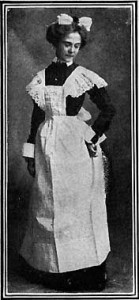Bessie Wallis (b. 1904) Life & Labour
‘As a generalization, the less literate the writer, and the less he was involved in specific activities of self-improvement or political activity, the greater his preoccupation with the details of his life as a worker’ Vincent, David, Bread Knowledge and Freedom, p. 62
Bessie’s memoir begins with an insight into the life of a working-class girl at the beginning of the twentieth century. Although life was hard for the Wallis’ they got by with lots of family and community spirit, ‘we were a small knit community’ (2, 1). The need to stay together as a community unit is highlighted in Bessie’s memoir. Credit is given to the people who provided Bessie with happiness in her younger years and she is nothing but appreciative to her working-class community; her younger years are expressed as some of the closest memories to her heart.
Bessie recalls the love for her childhood: ‘there was indeed something about those early yesterdays’ (6, 31). Although much of her memoir is about the happy times in West Melton, Bessie’s life can not be described as being easy. Every family member of a legal working age were workers; this included Bessie’s mother. Bessie expresses how in a working-class household there is no rest because of gender, although she felt a woman was deemed as less superior; ‘I was just a girl’ (4, 20).

When Bessie left education she did not have time to grieve for the loss of learning as she was straight into working for her grandparents. Bessie portrays her devastation for being unable to continue study and accept the scholarship she had been offered. Although she was unable to continue education her academic qualities were not gone unnoticed by her family as she was entrusted to be in control of the family shop’s account books. From a young age Bessie was introduced to the world of work. The rise of the new century meant the rise of new lifestyle, families were becoming aware that you could obtain a happier life if all the family worked. This meant that being a woman did not limit you to housework only; woman were now expected to start work as soon as they left education.
After leaving school Bessie was pushed to gain paid work for her aunt as a servant. This was not one of her fondest memories: ‘I was miserable… That world might have been my oyster. Instead I was to be just another skivvy’ (4, 20). this a period of depression in her life. The days were bleak and long for Bessie who longed for her West Melton home, although sadly she knew she was no longer welcome.

After returning from her Aunt’s residence after two years, Bessie did not wish to stay long at home. We become aware that although Bessie was from a working-class background she did not wish this to define her future. After moving to Leicester Bessie returned to education in the form of night school which with her academic record led her to London where she met her husband. Through her adult life Bessie continued in work and expressed how during the war she had worked at one of the leading banks in London. It is noted that Bessie wanted to prove that she had talent and her gender and class therefore should be ignored.
When comparing Bessie’s memoir to my opening quote of Vincent’s, it is evident through her textual approach and language that Bessie was very academic, but adding to this she included masses of information on life of a laborer. I believe this is an indication that Bessie was socially aware of class structure from a young age. Bessie was politically engaged in expressing how the histories of working-class individuals should be read and not just determined by their class.
References
Vincent, David. Bread, Knowledge and Freedom: Study of Nineteenth Century Working Class Autobiography. Routledge London, UK. 1982.
Wallis, Bessie. Yesterdays, Burnett Archive of Working Class Autobiography, University of Brunel Library, Special Collection, 2:0794
Image References
Costumes.Org. Historic Maid Aprons | The Costumer’s Manifesto: Servant’s Clothing of the Edwardian Era. Pininterest. Accessed 10/12/2015
http://schoolstarttime.org/early-school-start-times. Teacher in classroom. Accessed 10/12/2015

Leave a Reply